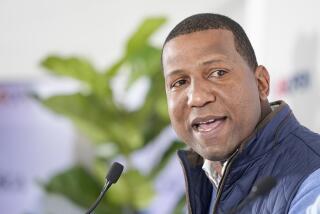World begins to pull rankings
We’ve seen it at the Ryder Cup and the U.S. Open, on the tournament and earnings ledgers of the PGA and LPGA Tours and, of course, in the Official World Rankings. In fact, if we exclude the unique greatness of Tiger Woods from the equation, overseas success in professional golf is currently at a level unmatched since the dawn of the last century, when British emigres were essentially the only serious competitors in any significant event anywhere on the planet.
Supporting numbers are plentiful, but are well summed up by these statistics:
Only 20 years ago, two foreign players (Greg Norman and Bernhard Langer) were among the PGA Tour’s top 20 money earners. By 2006, that number had grown to 10, including six of the top 10.
In that 1986 season, three foreigners won a total of four official tour events. In 2006, 13 foreigners won 15 tour titles.
On the LPGA Tour, where three overseas players claimed a total of five 1986 titles, international stars from Sweden, Mexico, Australia and most of Asia won an eye-popping 26 of the tour’s 34 official events in 2006.
Perhaps most telling, however, is the Official World Ranking, whose top 64 players are eligible to compete in this week’s WGC Match Play event in Marana, Ariz. In 1986, 21 of the season-ending top 64 were foreign players. By 2006, that number had climbed to 41, including 12 of the top 15 and 37 of the top 50.
This week’s tournament, which runs today through Sunday, features 41 foreign players in the field. It would have been 42 had South African Charl Schwartzel not withdrawn; he was replaced by American J.J. Henry.
How have foreign players come so far so fast?
Frequently cited answers are the game’s expanding global popularity, improved coaching and wider tournament opportunities, which, at least theoretically, produce more good players worldwide. Also significant is the number of foreign players competing at American high schools and universities, virtually unheard of 30 years ago. Today, Adam Scott (Australia), Luke Donald (England), Trevor Immelman (South Africa), Lorena Ochoa (Mexico) and Annika Sorenstam (Sweden) are only a sampling of the many top-flight foreigners who’ve logged significant competitive time in the United States as juniors or collegians or both.
These youthful tastes of top-flight competition are clearly aided by modern transportation, for Immelman and Scott surely find it much simpler to travel to and from their native lands than, say, Gary Player or Peter Thomson did circa 1960. Further, with American purses skyrocketing over the last three decades, the financial risks for a foreigner now wishing to give America a try are greatly reduced.
Indeed, the sort of 80th-on-the-money list season that would have sent earlier generations home C.O.D. now affords a fairly high standard of living. And for those who still come up shy, there is the opportunity of the Nationwide Tour, a developmental enterprise to be sure, yet one that gains PGA Tour playing privileges for its top 20 money winners while offering purses generally larger than those of most Asian, South African and Australian events. Thus even for the modern overseas player who is not substantially better than his 1960s or ‘70s predecessors, rolling the dice in America is clearly a much safer bet.
Beyond expanded competitive opportunities and rewards, however, lies an even more compelling factor: Foreign players, by and large, are simply more geared toward winning.
How, we may wonder, can any society produce people more psychologically primed to reach the top than America? The first answer lies in an odd competitive paradox: In many foreign countries, the rather limited competition faced by elite junior players accustoms them to winning on a regular basis. In America, however, where junior competition more resembles a scaled-down version of the PGA Tour, winning is comparatively rare, with the occasional triumph and a lot of top-10 finishes generally being enough to attract high-level college scholarship offers.
This focus on winning is further developed as young players reach their respective professional tours. In Australia, South Africa and Asia, for example, golfers looking to cash major paychecks generally must win with some regularity. To a very real extent, their livelihood -- or, at least, their ability to buy a second or third home -- depends on it. In America, on the other hand, where 10th place regularly pockets at least $125,000, merely making consistently good showings -- often without even climbing high enough to feel any real Sunday pressure -- can quickly make one a multimillionaire.
But there is yet another contributing factor that, in the last decade especially, has gone largely unnoticed in this foreign ascendance: the worldwide reach and growing prestige of the European PGA Tour. Within its official 2007 schedule, the European Tour is officially sanctioning or co-sanctioning events on five continents, including 10 events on the Asian Tour, three on the South African and two on the Australasian. This cross-breeding of tours does more than just fill out the Euro schedule with a dash of glamour; it also affords numerous faraway players a real opportunity to gain playing status in Europe simply by performing well on their home turf.
Gone are the days of traveling halfway around the world for a single, all-or-nothing shot at securing one’s playing privileges through a brief qualifying school. Today, with a handful of strong homeland showings, the doors to Europe -- where more world ranking points are now occasionally available than at competing PGA Tour events -- can readily be opened.
Talented young Americans, male and female, are in reasonably plentiful supply. But given the game’s expanded social mobility and the economic and competitive factors that help forge the foreign player’s winning mentality, the sheer number of capable Americans may not much matter. Given the myriad causes, this run of overseas golfing success seems unlikely to reverse itself any time soon.
*
(BEGIN TEXT OF INFOBOX)
Un-American
---
Seven of the top 10 players in the world rankings are foreign-born:
*--* 1. Tiger Woods United States 2. Jim Furyk United States 3. Adam Scott AUSTRALIA 4. Phil Mickelson United States 5. Vijay Singh FIJI 6. Ernie Els SOUTH AFRICA 7. Padraig Harrington IRELAND 8. Retief Goosen SOUTH AFRICA 9. Geoff Ogilvy AUSTRALIA 10. Luke Donald ENGLAND
*--*
More to Read
Go beyond the scoreboard
Get the latest on L.A.'s teams in the daily Sports Report newsletter.
You may occasionally receive promotional content from the Los Angeles Times.










